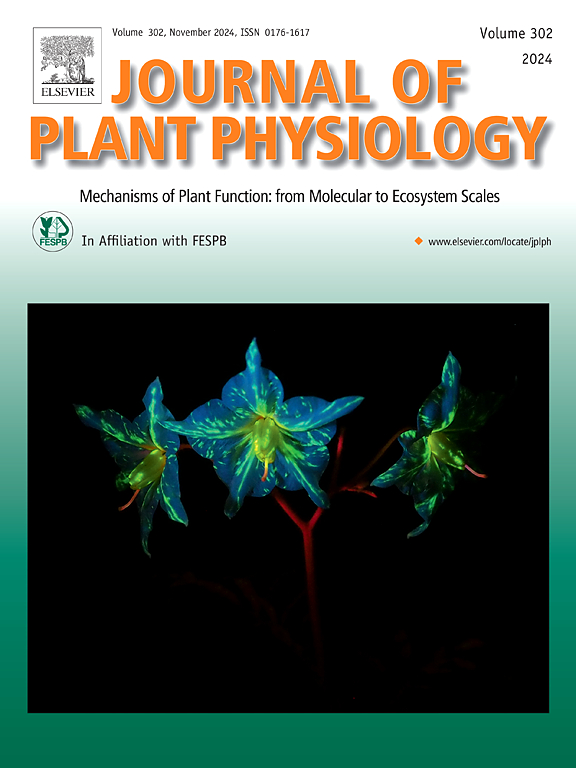在MeJA处理下,miR156a靶向的小桃F-box蛋白PmFBK2可能影响应激相关蛋白
IF 4.1
3区 生物学
Q1 PLANT SCIENCES
引用次数: 0
摘要
本研究探讨茉莉酸甲酯(MeJA)处理下小桃microRNAs (miRNAs)与F-box蛋白(fbp)的关系。mirna通过碱基配对切割或修饰mrna来调控基因表达,而fbp作为SCF (Skp1-Cullin-F-box)复合体的一部分,通过泛素- 26s蛋白酶体系统(UPS)介导蛋白质降解。这些转录后和翻译后调控因子共同作用,激活植物的反应。集成芯片分析和实验验证鉴定出5对miRNA-FBP: miR156a - pmfbk2、miR396a-PmFBX1、miR156a/ c-PmFBX2、miR408-PmFBK3和miR398-PmFBL1。其中,miR156a和miR408与其FBP靶点呈负表达相关,RLM-RACE进一步证实了这一点,表明miR156a和miR408与FBP靶点存在直接的转录后调控作用。这两个靶基因都编码含有kelch重复序列(FBK)的FBP,这是一个在植物中丰富的亚家族,与应激反应途径有关。通过酵母双杂交(Y2H)进一步分析miR156a靶点发现,PmFBK2蛋白靶向与应激反应相关的代谢和激素调节蛋白SAMS2、PAL1和GID1。这些发现表明,mirna介导的FBP调控可能影响与应激适应相关的蛋白相互作用网络。该研究为miRNA-FBP特异性相互作用参与植物胁迫应答提供了基础证据,为未来的功能验证和作物改良奠定了基础。本文章由计算机程序翻译,如有差异,请以英文原文为准。
Persicaria minor F-box protein, PmFBK2 targeted by miR156a in response to MeJA treatment, potentially affects stress-related proteins
This study investigates the relationship between microRNAs (miRNAs) and F-box proteins (FBPs) in Persicaria minor, under methyl jasmonate (MeJA) treatment. miRNAs regulate gene expression by targeting mRNAs via cleaving or modifying the mRNAs through base pairing, while FBPs, as part of the SCF (Skp1-Cullin-F-box) complex, mediates protein degradation via the ubiquitin-26S proteasome system (UPS). These post-transcriptional and post-translational regulators work together to activate plant responses. Integrated in silico analysis and experimental validation identified five miRNA–FBP pairs: miR156a–PmFBK2, miR396a–PmFBX1, miR156a/c–PmFBX2, miR408–PmFBK3, and miR398–PmFBL1. Among these, miR156a and miR408 showed negative expression correlations with their FBP targets, further confirmed by RLM-RACE cleavage assays, suggesting direct post-transcriptional regulation. Both target genes encode FBP containing kelch repeat (FBK), a subfamily abundant in plants and associated with stress-responsive pathways. Further analysis of the miR156a target through yeast two-hybrid (Y2H) revealed that, PmFBK2 protein targets SAMS2, PAL1 and GID1, proteins involved in metabolic and hormonal regulation linked to stress responses These findings suggest that miRNA-mediated regulation of FBP may influence protein interaction networks relevant to stress adaptation. This study presents foundational evidence for the involvement of specific miRNA-FBP interactions in plant stress responses, laying the groundwork for future functional validation and crop improvement.
求助全文
通过发布文献求助,成功后即可免费获取论文全文。
去求助
来源期刊

Journal of plant physiology
生物-植物科学
CiteScore
7.20
自引率
4.70%
发文量
196
审稿时长
32 days
期刊介绍:
The Journal of Plant Physiology is a broad-spectrum journal that welcomes high-quality submissions in all major areas of plant physiology, including plant biochemistry, functional biotechnology, computational and synthetic plant biology, growth and development, photosynthesis and respiration, transport and translocation, plant-microbe interactions, biotic and abiotic stress. Studies are welcome at all levels of integration ranging from molecules and cells to organisms and their environments and are expected to use state-of-the-art methodologies. Pure gene expression studies are not within the focus of our journal. To be considered for publication, papers must significantly contribute to the mechanistic understanding of physiological processes, and not be merely descriptive, or confirmatory of previous results. We encourage the submission of papers that explore the physiology of non-model as well as accepted model species and those that bridge basic and applied research. For instance, studies on agricultural plants that show new physiological mechanisms to improve agricultural efficiency are welcome. Studies performed under uncontrolled situations (e.g. field conditions) not providing mechanistic insight will not be considered for publication.
The Journal of Plant Physiology publishes several types of articles: Original Research Articles, Reviews, Perspectives Articles, and Short Communications. Reviews and Perspectives will be solicited by the Editors; unsolicited reviews are also welcome but only from authors with a strong track record in the field of the review. Original research papers comprise the majority of published contributions.
 求助内容:
求助内容: 应助结果提醒方式:
应助结果提醒方式:


